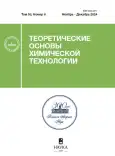Быстрая молекулярная реконструкция химического состава сложных углеводородных смесей
- Авторы: Глазов Н.А.1, Загоруйко А.Н.1
-
Учреждения:
- Институт катализа СО РАН
- Выпуск: Том 58, № 6 (2024)
- Страницы: 811-818
- Раздел: Статьи
- Статья опубликована: 15.12.2024
- URL: https://gynecology.orscience.ru/0040-3571/article/view/681300
- DOI: https://doi.org/10.31857/S0040357124060137
- EDN: https://elibrary.ru/VGYEMI
- ID: 681300
Цитировать
Полный текст
Аннотация
Предложен новый эвристический подход для проведения стохастической молекулярной реконструкции значительно быстрее. За основу взят двухступенчатый метод, объединяющий стохастическую реконструкцию и реконструкцию максимизацией энтропии. В предложенном методе поиск оптимальных параметров распределений осуществляется при решении нескольких сравнительно простых оптимизационных задач. Предложенный метод позволил реконструировать состав образца вакуумного газойля как минимум в 100 раз быстрее классического подхода с генетическими алгоритмами.
Полный текст
Об авторах
Н. А. Глазов
Институт катализа СО РАН
Автор, ответственный за переписку.
Email: glazov@catalysis.ru
Россия, Новосибирск
А. Н. Загоруйко
Институт катализа СО РАН
Email: glazov@catalysis.ru
Россия, Новосибирск
Список литературы
- De Oliveria L., Hudebine D., Guillaume D. A review of kinetic modeling methodologies for Complex Processes // Oil Gas Sci. Technol. 2016. V. 71. P. 45.
- Ren Y., Liao Z., Sun J. Molecular reconstruction: Recent progress toward composition modeling of petroleum fractions // J. Chem. Eng. 2019. P. 761.
- Neurock M., Nigam A., Trauth D. Molecular representation of complex hydrocarbon feedstocks through efficient characterization and stochastic algorithms // Chem. Eng. Sci. 1994. V. 49. № 24А. P. 4153.
- Hudebine D., Verstrate J. Molecular reconstruction of LCO gasoils from overall petroleum analyses// Chem. Eng. Sci. 2004. V. 59. P. 4755.
- Hudebine D., Verstraete J. Reconstruction of Petroleum Feedstocks by Entropy Maximization. Application to FCC Gasolines // Oil Gas Sci. Technol. 2011. V. 66. P. 437.
- De Oliveria L., Vazquez Trujillo A., Verstrate J. Molecular Reconstruction of Petroleum Fraction: Application to Vacuum Residues from Different Origins // Energy & Fuels. 2013. V. 27. P. 3622.
- Alvarez-Majmutov A., Chen J., Gieleciak R. Molecular-Level Modeling and Simulation of Vacuum Gas Oil Hydrocracking // Energy & Fuels. 2016. V. 30. P. 138.
- Zhao G., Yang M., Du W. A stochastic reconstruction strategy based on a stratified library of structural descriptors and its application in the molecular reconstruction of naphtha // Chin. J. Chem. Eng. 2022. V. 51. P. 153.
- Dantas T., Noriler D., Huziwara K. A multi-populating particle swarm optimization algorithm with adaptive patterns of movement for the stochastic reconstruction of petroleum fractions // Comput. Chem. Eng. 2023. P. 174.
- Deniz C.U., Yasar M., Klein M.T. Stochastic Reconstruction of Complex Heavy Oil Molecules using an Artificial Neural Network// Energy & Fuels 2017. V. 31. № 11. P. 11932.
- Alvarez-Majmutov A., Gieleciak R., Chen Jinwen. Deriving the Molecular Composition of Vacuum Distillates by Integrating Statistical Modeling and Detailed Hydrocarbon Characterization// Energy & Fuels. 2015. V. 29. № 12. P. 7931.
- Skander N., Chitour C.E. A new Group-contribution method for the estimation of Physical properties of Hydrocarbons// Oil Gas Sci. Technol. 2002. V. 57. № 4. P. 369.
Дополнительные файлы











